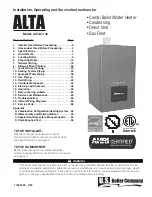
Page 36
Figure 37.
Indicates a call for heat
Figure 38.
The Ignition LED’s light in sequence
SECTION 9 INITIAL STARTUP
9.A Filling the System
It is crucial to the efficient operation of the system
that all air be removed from the circuit. For this
reason, an air scoop and vent should be located close
to the boiler outlet, and there should be a minimum
distance between cold water feed and air elimination
system.
1. When the system has been completely installed, and
is free of leaks, open all automatic air vents and close
all manual vents. Open the makeup water valve.
2. Close isolation valves. Operate purge and waste
stations to purge each circuit one at a time, allowing
a water makeup system to maintain pressure. During
this purging process excess pressure can speed
along the air removal but ensure pressure in the boiler
doesn’t exceed 30PSI or the relief valve will open.
3. Open all valves after all circuits have been purged.
4. Run the boiler pump for a minimum of 30 minutes with
the boiler shut off. If using system pump terminals, the
control won’t start the pump(s) until the outlet exceeds
150°F. To cool purge these zones, turn off power and
temporarily connect the lead to the Aux Power Terminal.
Turn on power and purge the zones. Then after
purging process is complete turn power off and return
the lead to Sys pump terminals.
5. Open all strainers in the system, and check for debris.
6. Recheck all automatic air vents to ensure that they are
open.
7. Setup boiler according to the procedures described
in SECTION 8 and operate the system, including the
pump, boiler, and radiation units, for one hour.
8 . Close the water makeup valve and re-check all
strainers for sediment or debris. Re-open the water
makeup valve.
9. Ensure make up regulator is adjusted to maintain
12-15 PSI with matching charge in the properly sized
expansion tank. Verify system pressure with the boiler
pressure gauge before beginning regular operation.
10. Within 3 days of start-up, recheck and bleed all air
vents using these instructions. It’s critical that air
elimination devices are functioning properly to prevent
air locked zones and boiler damage.
SYSTEM START-UP
1
Carbon monoxide hazard. The vent damper must be fully open and the flue must be clear
before the main burner fires. If the burner fires when the vent damper is not fully open or the
flue is blocked, dangerous flue products such as carbon monoxide will escape into the house
causing severe personal injury or death. The vent damper and flue must be checked for
proper operation before allowing the system to operate.
Electrical shock hazard. The ignition circuit of the control can produce over 10,000 volts
which can cause severe injury or death.
Decimal lights on a call for heat.
LEDs light in sequence.
9.B System Start Up (Sequence of
Operation)
1. Raise the thermostat temperature to call for heat.
The third decimal, lower right of the Control display
will light indicating a call for heat.
2. The external limits will be confirmed. If the external
limits are closed the green LIMITS LED will turn on.
If the limits are not satisfied the green LIMITS LED
will blink and the start up sequence will stop until
the limits are satisfied and the green LIMITS LED is
on.
3. Power is sent to the vent damper and the green
V-PWR LED will light. The damper will begin to
open. Power vent and air make up units will start if
connected to PV1, PV2 and PV4.
4. The vent damper, power vents and air makeup units
end switches will close. The green V-SW LED will
light when the end switches close. If the switches
do not close in 30 seconds the green V-SW LED
will blink. The startup sequence will stop until
corrected.
WARNING
Carbon monoxide hazard. The vent damper must be
fully open and the flue must be clear before the main
burner fires. If the burner fires when the vent damper
is not fully open or the flue is blocked, dangerous flue
products such as carbon monoxide will escape into
the house causing severe personal injury or death.
The vent damper and flue must be checked for proper
operation before allowing the system to operate.
5 The spark will energize and the pilot valve will turn
on. There will be an audible spark every 1 second
until flame is sensed.
6. When pilot flame is sensed the green FLAME LED
will turn on. If flame is not sensed in 75 seconds the
pilot valve will de-energize, the spark will terminate,
and the green FLAME LED will blink. After a 5
minute delay the sequence will retry at step 5. There
will be an unlimited number of retries.
LAARS Heating Systems
















































